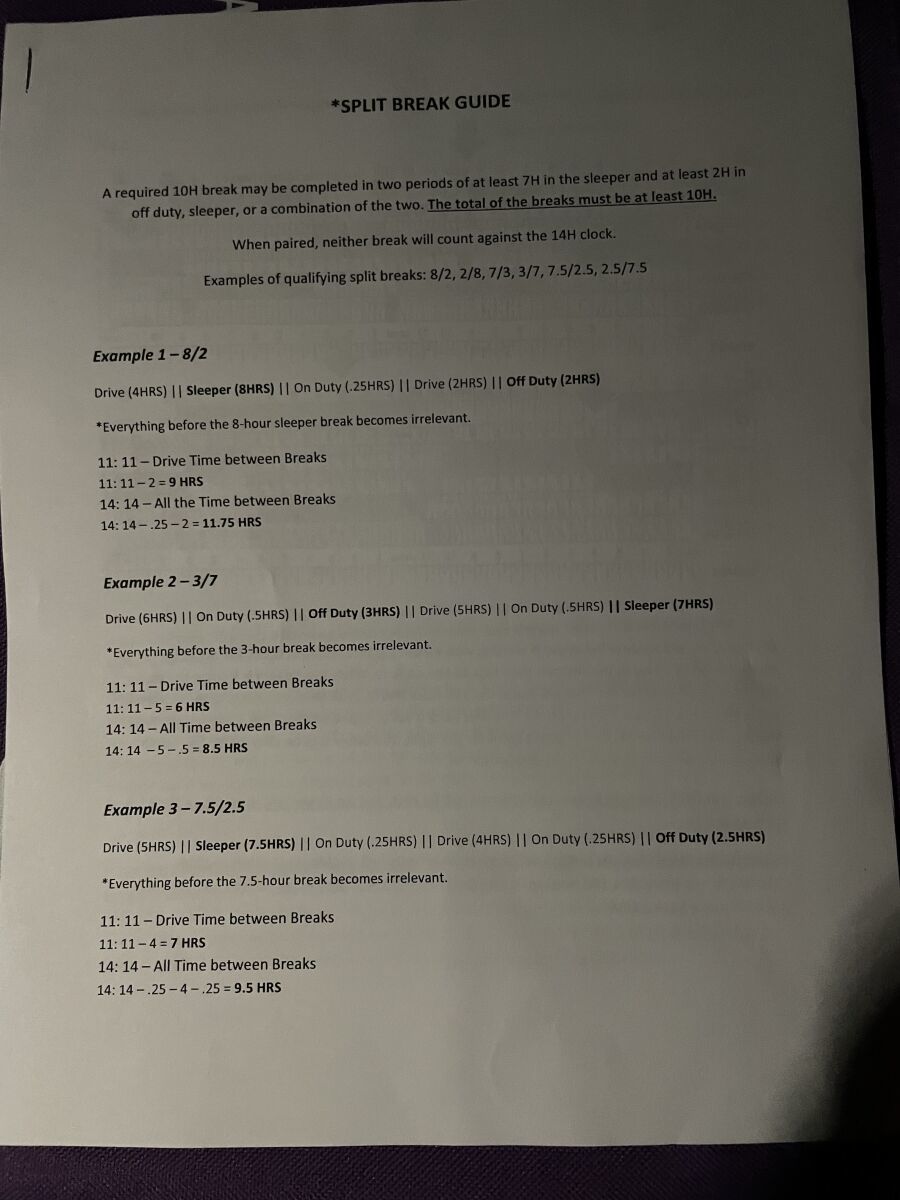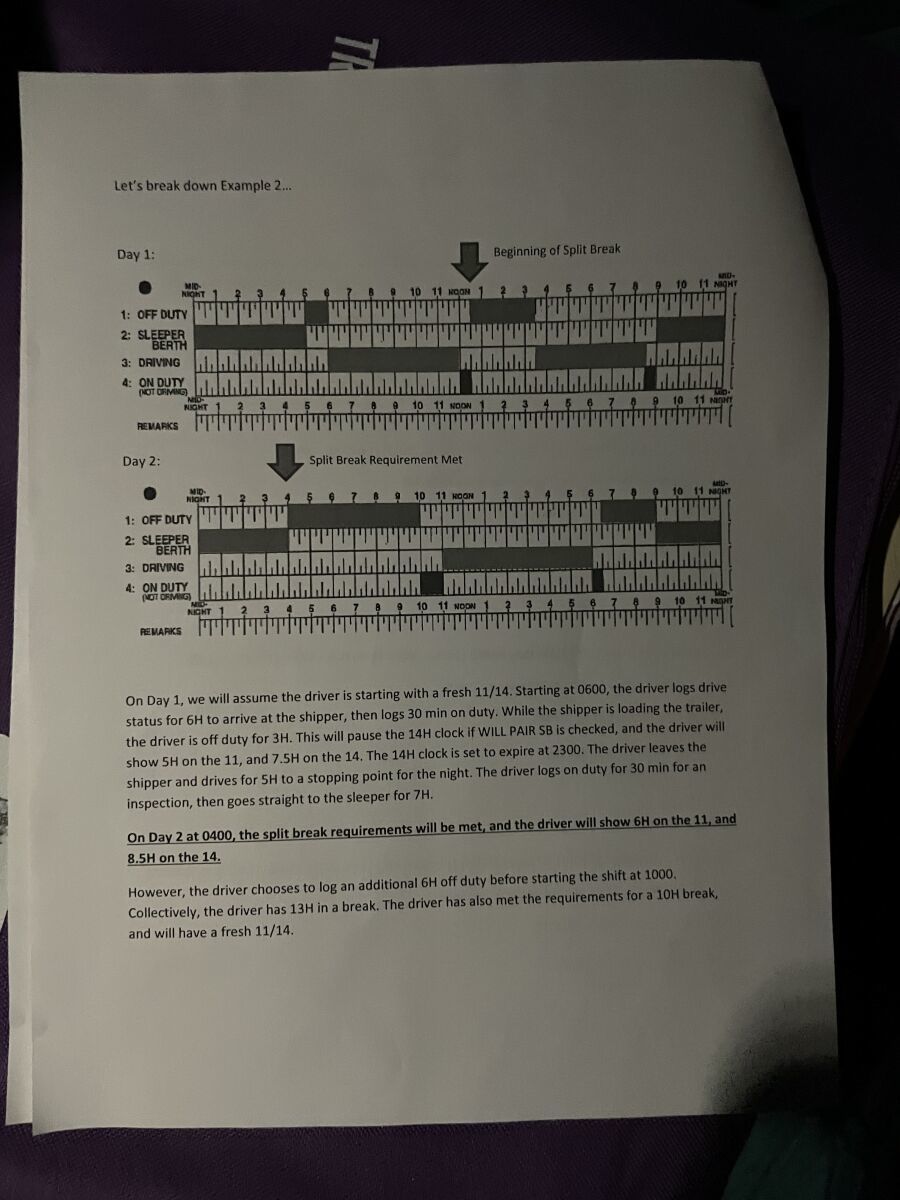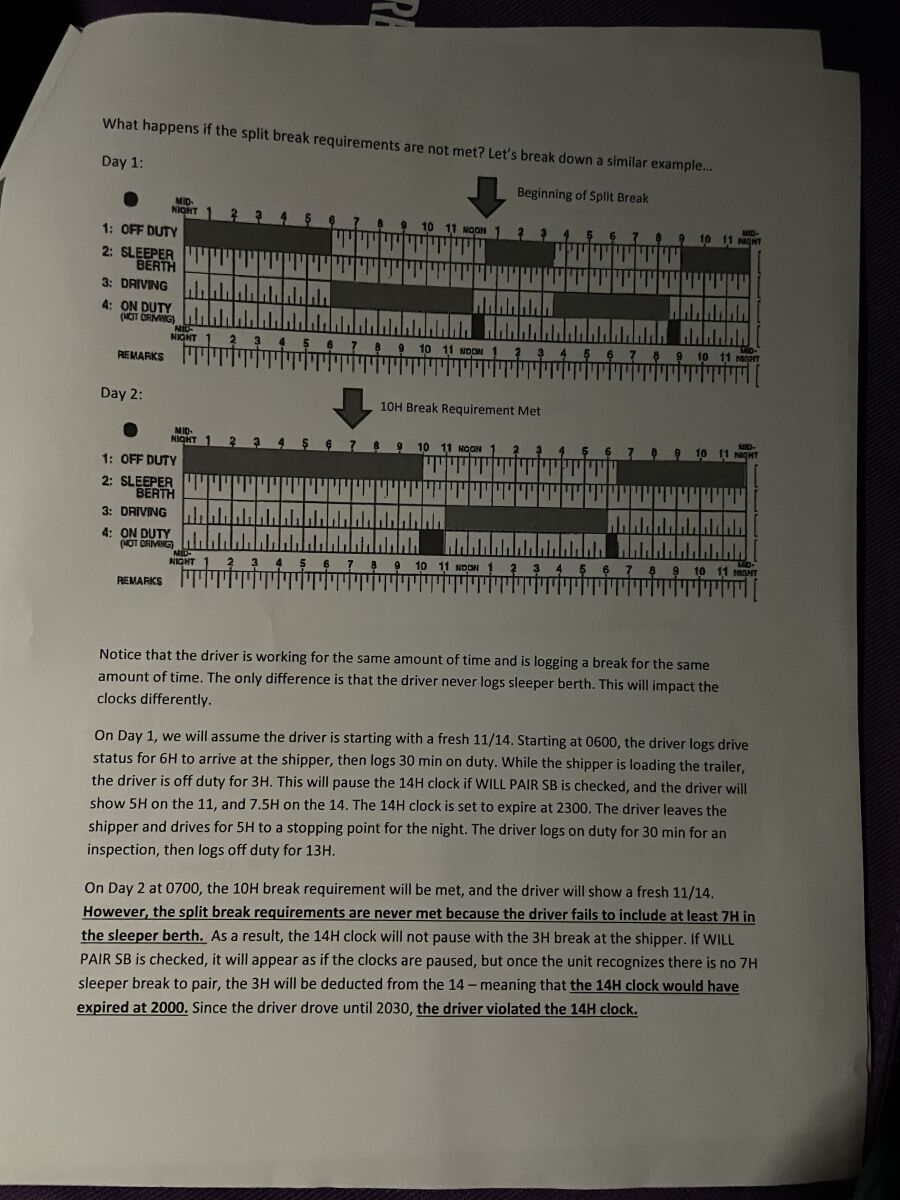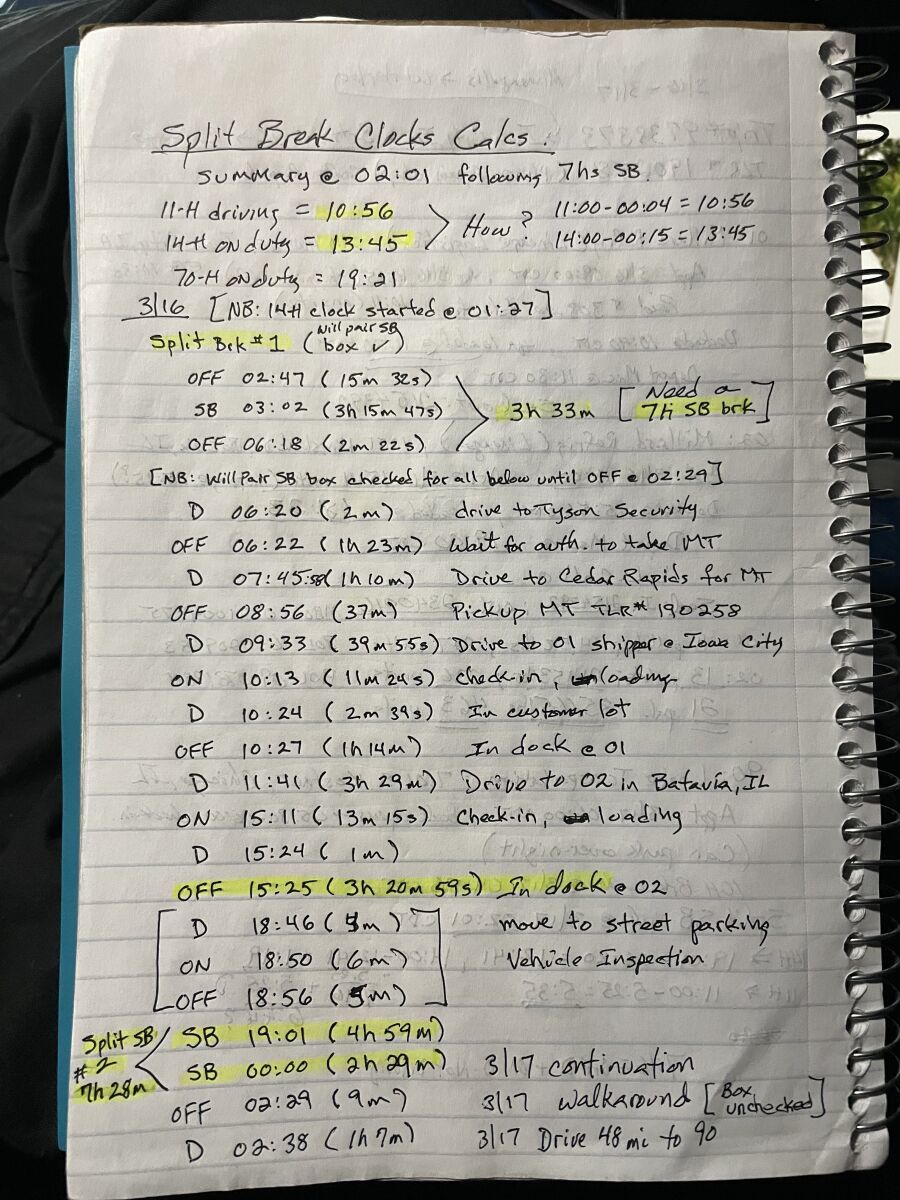Split Sleeper Berth Example
Topic 32987 | Page 1
Dennis, that’s very impressive. You are way ahead of me with using split sleeper. I don’t feel too bad, though. I recently talked to one of our drivers with 15 years experience. When I asked him about using split sleeper, he said: “I don’t use it because I don’t understand it”

I’m sharing my split SB experience from 3/16-3/17 as it may help some newbies understand how it works. The photo details my day log entries starting from when I initiated the split SB.
My 14-H clock started at 01:27.
I initiated the short split break #1 from 02:47-0:620 (3h 33m).
I took the required 7h SB break from 3/16 19:01 - 3/17 02:29 (7h 28m).
When I went to bed I thought that I was only going to get back 1h 19m on my 14-H clock and 5h 35m for 11-H drive clock. This was from subtracting the times 19:01 back to 06:20.
I was pleasantly surprised when I found my available time as 13h 45m on 14-H and 10h 56m on 11-H clocks.
How did this happen?
It turned out that I had taken another Off Duty break of 3h 21m from 15:25-18:46 while in my second pickup customer dock. I used a small amount of time afterwards moving to park on the street.
The ELD recognized the second long break as a qualifying split SB break, so used it instead of the split break from early morning.
When I shutdown for the night I only had about 6 minutes left on my 14-H clock.
Knowing how this works now could be a useful strategic tool when working a long day as I did in this example.
Per FMCSA , DOT is supposed to interpret use of breaks, including split breaks in ways that are most favorable to the driver. That said, sometimes ELDs will do this, but sometimes they will do the opposite, as has been shared on this forum. Try to avoid having more than one qualifying split break on the front half for the ELD to pick from because it may pick one that shows you in violation. You are not actually in violation, but then you are trying to calculate what your clock should actually be, communicating with Safety about getting your logs corrected, and worrying about a possible inspection with a violation showing.
One trick to avoid more than one available split period on the front half of a split break is to interrupt a break with on duty time. Log pre-trip or post-trip and walk around the truck and trailer looking for issues. It's good practice to look for potential issues, even if it's not the start nor end to the shift.
Ok, so put this into practical analysis. I start my day at 08:00 and drive 3 hours to a shipper. I am at the shipper for 2 hours, 30 minutes after checking in. I select this break period to be the first half of a split break. I have 11 hours of on duty time available and 8 hours of drive time available, after stopping at the shipper. I drive 6 hours to the first of two deliveries. I check in and go off duty. I am at the receiver for 1 hour, 30 minutes. I log post-trip inspection and walk around the truck and trailer to look for issues. I am at the receiver for 45 more minutes after going back to off duty status.
Sometimes it's advantageous to use a later break in the day for a split, as opposed to the first. Be careful because it's possible to then put yourself in violation because using a later break means the first break didn't pause your clock.
Shipper:
The customer who is shipping the freight. This is where the driver will pick up a load and then deliver it to the receiver or consignee.
CSA:
Compliance, Safety, Accountability (CSA)
The CSA is a Federal Motor Carrier Safety Administration (FMCSA) initiative to improve large truck and bus safety and ultimately reduce crashes, injuries, and fatalities that are related to commercial motor vehicle
FMCSA:
Federal Motor Carrier Safety Administration
The FMCSA was established within the Department of Transportation on January 1, 2000. Their primary mission is to prevent commercial motor vehicle-related fatalities and injuries.
What Does The FMCSA Do?
- Commercial Drivers' Licenses
- Data and Analysis
- Regulatory Compliance and Enforcement
- Research and Technology
- Safety Assistance
- Support and Information Sharing
DOT:
Department Of Transportation
A department of the federal executive branch responsible for the national highways and for railroad and airline safety. It also manages Amtrak, the national railroad system, and the Coast Guard.
State and Federal DOT Officers are responsible for commercial vehicle enforcement. "The truck police" you could call them.
Fm:
Dispatcher, Fleet Manager, Driver Manager
The primary person a driver communicates with at his/her company. A dispatcher can play many roles, depending on the company's structure. Dispatchers may assign freight, file requests for home time, relay messages between the driver and management, inform customer service of any delays, change appointment times, and report information to the load planners.OWI:
Operating While Intoxicated
Thanks for the analysis Ryan. I’ll study it closer as I get a chance. I just shutdown for the the night.
Like Ryan said, if I know I have two stops, and both are likely to be more than two hours, I'll write myself a timestamp on my windshield, and do a walk around. If my second stop winds up also being over two hours, I'll actually edit that first off duty stretch to include that quick walk around. Yeah, I lose those first two hours off my 14, but it effectively stops the 14 where I need it to.
HOS:
Hours Of Service
HOS refers to the logbook hours of service regulations.This is something I tried once and failed at, I posted that experience in a different thread. Maybe this is hard to answer, but does anyone think SSB benefits a certain type of driver more than others? Maybe it's common sense but trying to wrap my rookie brain around it I think reefer drivers seem to use it more. Is that sort of accurate? I know Old School talks about it so I know Flatbedders and everyone can benefit from it too. It's something I'd like to be more well-versed in.
Reefer:
A refrigerated trailer.
does anyone think SSB benefits a certain type of driver more than others? Maybe it's common sense but trying to wrap my rookie brain around it I think reefer drivers seem to use it more. Is that sort of accurate?
I like having this option as part of my HOS bag of tricks, although I may only utilize it perhaps once or twice most months. I've been pulling dry vans exclusively for the previous 15 months.
Dry Van:
A trailer or truck that that requires no special attention, such as refrigeration, that hauls regular palletted, boxed, or floor-loaded freight. The most common type of trailer in trucking.Reefer:
A refrigerated trailer.
TWIC:
Transportation Worker Identification Credential
Truck drivers who regularly pick up from or deliver to the shipping ports will often be required to carry a TWIC card.
Your TWIC is a tamper-resistant biometric card which acts as both your identification in secure areas, as well as an indicator of you having passed the necessary security clearance. TWIC cards are valid for five years. The issuance of TWIC cards is overseen by the Transportation Security Administration and the Department of Homeland Security.
HOS:
Hours Of Service
HOS refers to the logbook hours of service regulations.The Logbook section of the High Roads Training covers split sleeper berth applications. Review it there.
Some drivers don’t use it because you don’t get your full clocks back. I typically take a full 10 hours break as my second long break of the split being certain to log the required 7 or 8 consecutive hours in SB to legally satisfy the original split.
In my example I couldn’t do that because I wouldn’t make my delivery appointment in Chicago the next morning.
The second 3+ hour short split break in my example was unintentional, it just happened that way. I understand what Ryan B and NaeNae are saying to avoid having two short split breaks and an unintentional rule violation.
Prime offers some simple examples.



Logbook:
A written or electronic record of a driver's duty status which must be maintained at all times. The driver records the amount of time spent driving, on-duty not driving, in the sleeper berth, or off duty. The enforcement of the Hours Of Service Rules (HOS) are based upon the entries put in a driver's logbook.
Sleeper Berth:
The portion of the tractor behind the seats which acts as the "living space" for the driver. It generally contains a bed (or bunk beds), cabinets, lights, temperature control knobs, and 12 volt plugs for power.
I pull a reefer but rarely have a situation where SSB is necessary.
From the previous comments, my impression is that SSB is the most useful to drivers who have multiple stops on their assignment. My assignments are just point A to point B and I normally have enough time allowed so that I don’t have to worry about using SSB. That simplifies things for me and I like things to be as simple as possible.
Reefer:
A refrigerated trailer.

It's most useful for drivers who are stopping multiple times during a shift, but it's not exclusive to such drivers. I have multiple stop loads about 1 per week lately, and the ability to pause my clock is how I am able to make deliveries legally. When pausing my clock with a short break, I usually take a full 10 for my ling break. The use of the split was a means to pause my clock. Every load and situation for me is different, so I plan things out and use my clock according to the particular situation of that load. Once using split sleeper several times, even messing up trying to use it, you can become proficient at determining how to use it for various situations.
New Reply:
New! Check out our help videos for a better understanding of our forum features

















Preview:









 TT On Facebook
TT On Facebook
I’m sharing my split SB experience from 3/16-3/17 as it may help some newbies understand how it works. The photo details my day log entries starting from when I initiated the split SB.
My 14-H clock started at 01:27.
I initiated the short split break #1 from 02:47-0:620 (3h 33m).
I took the required 7h SB break from 3/16 19:01 - 3/17 02:29 (7h 28m).
When I went to bed I thought that I was only going to get back 1h 19m on my 14-H clock and 5h 35m for 11-H drive clock. This was from subtracting the times 19:01 back to 06:20.
I was pleasantly surprised when I found my available time as 13h 45m on 14-H and 10h 56m on 11-H clocks.
How did this happen?
It turned out that I had taken another Off Duty break of 3h 21m from 15:25-18:46 while in my second pickup customer dock. I used a small amount of time afterwards moving to park on the street.
The ELD recognized the second long break as a qualifying split SB break, so used it instead of the split break from early morning.
When I shutdown for the night I only had about 6 minutes left on my 14-H clock.
Knowing how this works now could be a useful strategic tool when working a long day as I did in this example.
OWI:
Operating While Intoxicated